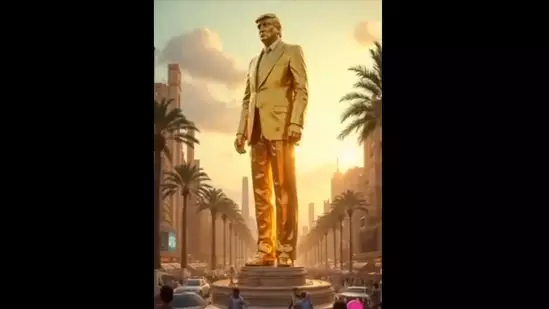In an audacious move that encapsulates his penchant for sensationalism, Donald Trump recently unveiled an AI-generated video on his Truth Social platform, ostensibly promoting his plans to seize and redevelop Gaza. This video, devoid of any explanatory caption, launches with visuals of the beleaguered region. With the phrase “Gaza 2025… What’s Next?” superimposed on the screen, it quickly transitions into fantastical imagery depicting a utopian sight filled with Trump-branded skyscrapers, pristine beaches, and even golden statutes of Trump himself. Notably, the surreal representation also includes AI-generated figures such as Elon Musk and an outlandishly absurd scene with Trump and Benjamin Netanyahu, further diminishing the gravity of the situation in Gaza to mere entertainment.
The soundtrack of the video is equally problematic, featuring a jingle that cavalierly asserts Trump’s arrival as a beacon of hope for Gazans. Lyrics like “Donald’s coming to set you free” and “no more tunnels, no more fear” resonate jarringly against the backdrop of persistent conflict and suffering in the region. This stark contrast serves not just to trivialize the complexities of the Middle East but also questions the sincerity of Trump’s intentions.
Unpacking Trump’s Strategy and Its Implications
During a recent press conference alongside Israeli Prime Minister Benjamin Netanyahu, Trump articulated his controversial vision of the United States “taking over” the Gaza Strip. He posited a scenario where the U.S. would be responsible for dismantling weapons, clearing debris, and ultimately driving economic development. According to Trump, this would not only level the land but also usher in an era of prosperity with jobs and housing for the local populace. However, such claims warrant scrutiny.
Firstly, Trump’s approach suggests a simplistic understanding of a deeply intricate geopolitical problem. A history marred by conflict, humanitarian crises, and global interference cannot simply be erased in a brash declaration coupled with lofty promises. Expectations of modernization and economic growth presuppose an environment free of violence and political unrest—conditions that, to date, have proven elusive in Gaza.
Local critiques underscore the deeper issues at play. Wassel Abu Yousuf, a member of the Palestine Liberation Organization (PLO) executive committee, aptly dismissed Trump’s video as a “clowning gimmick,” emphasizing the repercussions of reducing historic grievances to the realm of entertainment. He asserts that any plans emerging from such a shallow understanding must reckon with the lands’ historical significance to the Palestinian people and cannot be merely sculpted to fit an American developer’s fantasy.
Regional Responses and Diplomatic Considerations
Reactions from neighboring Arab nations reveal the extent to which Trump’s proposals are perceived as out of touch. Leaders from Egypt, Jordan, and several Gulf states convened to explore collaborative efforts to protect Palestinian rights and avoid further displacement. Their swift acknowledgment of the need for a more nuanced and respectful approach underscores a significant pushback against perceived Western imperialism masked as altruism.
In response to mounting criticism, Trump maintained that his strategy was the only viable solution, arrogance personified in his refusal to consider alternative viewpoints or diplomatic negotiations that have historically tried to address the complexities of the Israeli-Palestinian conflict. This insistent adherence to a singular narrative not only risks exacerbating existing tensions but also undermines genuine opportunities for peace.
In an era where technology interweaves with politics, Trump’s AI-generated video serves as a poignant reminder of how distorted visions can emerge from misunderstanding intricate realities. While the allure of a modernized Gaza painted with rosy optimism captures imaginations, it does a disservice to the myriad voices and histories intrinsic to the region. Moving forward, it is crucial that discussions surrounding Gaza prioritize empathy, respect, and a commitment to authentic storytelling over sensationalized soundbites. Only through this lens can we hope to chart a path toward genuine reconciliation and healing in a region that has long suffered under the weight of conflict.

